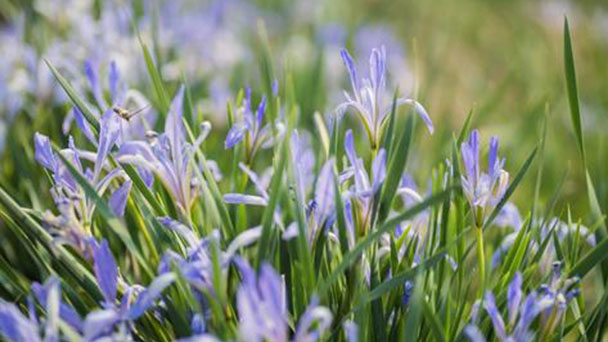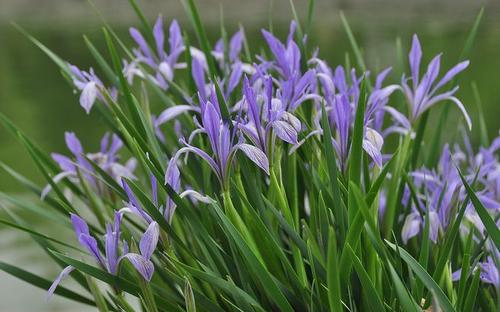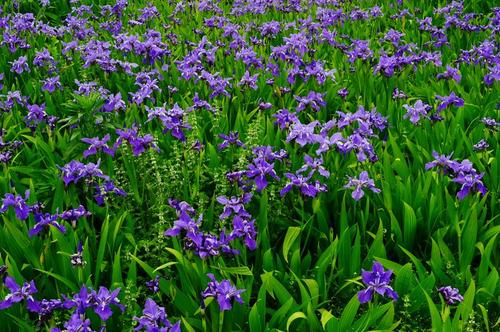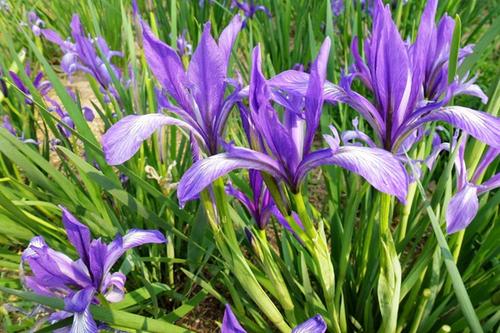Iris lactea profile
Written by Maggie
Aug 24 2021

Iris lactea is a perennial herbaceous plant of Iris family, a variety of Iris white flower, and a dense perennial herb. It has the effect of clearing away heat and detoxification, relieving food, relieving urine, dispersing blood stasis and stopping bleeding, widely distributed in South and East Asia.
Iris lactea picture

Morphological characteristics of Iris lactea
Iris lactea is a perennial herb, underground a slender rhizome, prostrate prostrate, white knot. In early spring only basal leaves stem is not obvious, early summer on the ground stem heightens, the base of the green purple, smooth hairless. Leaves are alternate nearly sessile, leaf obovate, elliptic to lanceolate. iris lactea blossoms in late autumn, with a flower head. Achene flat obovate, less crested, weak and easy to fall off. Stems are erect, 30-80 cm tall. Cauline leaves are lanceolate, obovate-oblong, 3 -- 7 cm long, 1 -- 2.5 cm wide, margin with 2 -- 4 pairs of shallow teeth above middle, upper leaves small, entire. Inflorescences are sparsely cymbose, involucre hemispherical, 6 -- 9 mm in diameter, involucre 2 -- 4 layers. Margin is liguulate, purple; Inner flower is tubular, yellow.
The distribution of Iris lactea
Iris lactea is widely distributed in the eastern, central, western, southern and southern regions of China. Iris lactea also exists in northern China and is widely cultivated in Dongying, Shandong Province. The varieties in this area have good alkali resistance and are excellent crops for alkaline land greening. It has beautiful purple or yellow flowers in spring
Ecological habits of Iris Lactea
Iris lactea is fond of fertile soil, drought and waterlogging resistance, strong life, in the vegetable garden, farmland, roadside, as a common weed in the field.
Growing techniques of Iris lactea
Field management
Iris lactea has strong adaptability to soil, but the sandy loam soil with good water conservancy facilities and convenient drainage and irrigation is better. Before transplanting, weeds are pulled out manually or sprayed with pollue-free herbicide. At the same time, 5000kg of high quality fermented and decayed pig or cow dung is applied every 667m2 in combination with ploughing, so as to achieve sufficient base fertilizer and blend of soil and fertilizer, laying a good foundation for the lasting and vigorous growth of Ma 'anthus. Then prepare the land for the bed, the width and length of the bed according to the size of the field and greenhouse cover standards, general land utilization requirements in more than 90%. The good weeding and fertilizer is the basis of obtaining the safety, high quality and high yield of Malan, can not be taken lightly.
Transplanting
Iris lactea is usually transplanted in September and covered with plastic greenhouses in early November. Greenhouses can choose simple bamboo greenhouses, or movable steel greenhouses, the width and height of greenhouses are the same as conventional vegetable greenhouses, and it is required to achieve good thermal insulation performance, convenient operation in the field, and the growth and field operation of Elimaran.
Greenhouse Iris lactea to implement green management. After more than 4 years of practice, there was no serious harm of diseases and insects during the autumn and winter growth of greenhouse Iris lactea, so there was no need for spraying control. Occasional spotty leaf spot, with ash spread prevention and control. Therefore, the shed is more favored by the majority of consumers.
When the seedling height is 10 ~ 15cm, the tender shoots can be cut with scissors and listed. Generally, shears are taken once every 10 ~ 15 days. Picking and cutting attention to keep short buds, in order to ensure the later yield. After cutting, the tender shoots should be placed in damp pottery pots, sprayed with fine water to prevent wilting, packed in fresh bags and sent to the market in time for sale, so as to cut on time and keep fresh on the market.

Harvest
After each harvest, nitrogen fertilizer should be applied in time. Because the harvest interval is short, should be applied to rarefied
Human excrement and urine, or green environmental protection type quick-effect organic granular fertilizer, or green environmental protection type quick-effect organic liquid fertilizer. Do not apply quick-effect chemical nitrogen fertilizer, to ensure the safety and quality of greenhouse Malan.
Under the condition of artificial cultivation, greenhouse Malan is a kind of vegetable which can be harvested all the year round, and it can be harvested continuously for many years once planted. As long as the four seasons continue to cut the tender shoot, it will continue to grow a tender shoot, will not blossom, will not seed, continuously for people to cut and eat. After the Tomb Sweeping Day, remove the plastic film on the shelf of the greenhouse and let it grow naturally. As long as the management and fertilization are frequent, the yield of the tender shoots is higher than that of the greenhouse covering period, and the fragrance is rich and the quality is good. Because of its strong resistance to diseases and insects. It is generally not necessary to use medicine for insect control and disease prevention. Especially in the off-season of vegetables in July and August, the artificial cultivation of Malan fills the vacancy of vegetables in the middle of the off-season. Although the price is lower than during the Spring Festival, its economic benefit is still 1 ~ 2 times higher than that of general vegetables.
Iris lactea propagation methods
There are two kinds of propagation methods of Iris lactea: seed propagation and plant propagation. Seed propagation is generally not used because of the difficulty of seed collection and low seedling emergence rate. The method of plant division propagation (nutritional propagation) is not only simple and easy to operate, low cost and high survival rate, but also can be harvested in the same year when the seeds are collected and planted, and the cost can be recovered with a slight surplus in the same year when the management is proper. The method is: in September in the field (such as the head of the field, the two sides of the ditch, the slope of the mountain) with a shovel or hoe root with a trodge (dig), break the seed bark into a number of small seed roots with main branches and rhizome, each small root has 3 ~ 4 branches of the main stem of Iris lactea, and then according to the row of 10cm×10cm plant spacing to the field. When transplanting, the seed roots should be compacted so that they are tightly bound to the soil. After planting, it is necessary to pour water in time to prevent wilting and improve the survival rate.
There are many varieties of Iris lactea, of which there are 3 varieties and 3 varieties. To the field shovel seeds to collect those short stubby reddish roots, plants creeping growth, dark green leaf color, obovate oblong or oblanceolate leaves, leaf margin teeth or pinnately lobed plants. Only by propagating varieties with good regeneration, fast growth, wide adaptability, easy cultivation, strong resistance to adversity, environmental protection (without the need to control pests and diseases) and delicate fragrance, can we guarantee the high quality, high yield and good benefit of Malanum. This is one of the key technical aspects of growing a good maran.
Disease control of Iris lactea
The lactea has a strong resistance to pests and diseases and is generally free of pests and diseases.
In the Hengshui area, Iris lactea is often harmed by the small geoglyphs. The small geoglyphs occur three generations a year. The small larvae eat the leaves into holes and notches, while the older larvae lurk in the root soil during the day, and cut off the rhizome near the ground in the evening and night, causing the plant leaves to dry up and affecting the ornamental effect.
The control effect was best before the 3rd instar of larvae.
Add 5% phoxim particles to fine soil 30 times, mix them well and spread them evenly on the lawn. Or spray 50% phoxim liquid 1000 times liquid.
Black light lamps or sweet and sour liquid lure kill adult insects, set time from early March to the end of May.
Place a large tank of water under the lamp and sprinkle oil on the water surface.
The configuration method of sweet and sour liquid is: brown sugar 1, vinegar 3, water 10, join a small amount of trichlorfon liquid stir evenly. In the evening when there is no wind and clear weather, the moths are placed among the seedlings. After dawn, the moths are collected and buried deep.
After the plant is gnawed, the upper leaf death, after prevention and treatment can also drill a new leaf from the base, to restore the vitality of the past.

Latest Updated
- Benefits of Bugleweed - 7 Science-backed Health Benefits
- Bugleweed Dangers & Side Effects - Is It Poisonous?
- How to Plant Evergreen Trees - What You Should Know
- When to Plant Evergreens - Grow Guide for Evergreen Trees
- 12 Wonderful Evergreen Shrubs for Your Garden
- 12 Popular Evergreen Plants with Pictures for Beginners
- When And How To Prune A Lilac Bush Like a Pro
- How to Grow & Care for Lilac Vine (Hardenbergia Violacea)
- Japanese Lilac Tree (Syringa Reticulata) Care & Propagation Guide
- Shumard Oak Pros and Cons - What to Know
Popular Articles
- Winter maintenance of Antirrhinum Majus
- How to Grow Terminalia Mantaly Tree
- How to Grow and Care for Crossostephium Chinense
- How to grow Antirrhinum Majus in spring
- Peristeria Elata (Dove Orchid) Profile: Info & Care Guide
- Underwatered Snake Plant (Sansevieria Trifasciata) - Signs And How To Fix
- How to Care for Brazilian Jasmine Plant (Mandevilla Sanderi)
- How to Grow & Care for Graptopetalum Purple Delight in Summer
- Rosa Chinensis (China Rose): Plant Growing & Care Tips
- How to Care for Baby Sun Rose (Aptenia Cordifolia)